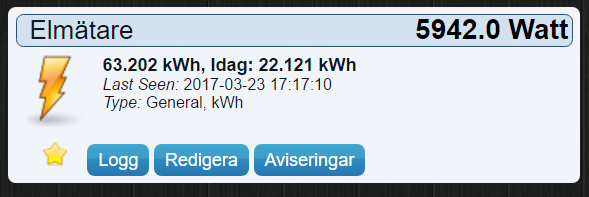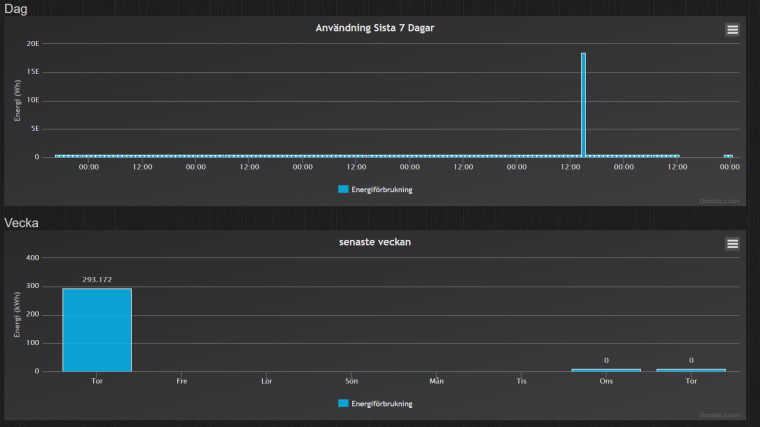💬 Power Meter Pulse Sensor
-
I think I found a problem: the WATT calculation is returning values over 172000 watts and since I put 10000 as the max value, it was not sending anything. I double checked my energy meter and indeed it is 1000 pulses per KWH and this is what I set in sketch
-
Here is the log I get from node
7230 TSF:MSG:READ,0-0-250,s=1,c=2,t=24,pt=0,l=7,sg=0:1682675 rece Received last pulse count from gw:1682675 11817 TSF:MSG:SEND,250-250-0-0,s=1,c=1,t=17,pt=5,l=4,sg=0,ft=0,st=OK:528 Watt:528 Watt:197065 21820 TSF:MSG:SEND,250-250-0-0,s=1,c=1,t=24,pt=5,l=4,sg=0,ft=0,st=OK:1682677 21913 TSF:MSG:SEND,250-250-0-0,s=1,c=1,t=18,pt=7,l=5,sg=0,ft=0,st=OK:1682.6770 Watt:196807 36824 TSF:MSG:SEND,250-250-0-0,s=1,c=1,t=24,pt=5,l=4,sg=0,ft=0,st=OK:1682679 36917 TSF:MSG:SEND,250-250-0-0,s=1,c=1,t=18,pt=7,l=5,sg=0,ft=0,st=OK:1682.6790 Watt:197368 51827 TSF:MSG:SEND,250-250-0-0,s=1,c=1,t=24,pt=5,l=4,sg=0,ft=0,st=OK:1682681 51920 TSF:MSG:SEND,250-250-0-0,s=1,c=1,t=18,pt=7,l=5,sg=0,ft=0,st=OK:1682.6810 Watt:196850Am I the only one using this sketch?
-
Please post you sketch.
-
How is the pulse counter set up? Is it connected to the S0 port?
Edit:
If you are using S0 it is vital that you use a pull down resistor, if you dont’t have that you get false pulses.

-
I'm using the lm393 light detector. Domoticz is able to do a calculation from the pulses to give a Watt value and it is correct but it does it every 5 minutes and it is too slow for me
@gohan - is Domoticz updating anything (except switches) faster than 5 min? I dont think so...
-
Just changed from 1-wire counter to MySensors for logging my power consumption. Using the same LED detector as I did when using 1-wire. Also changed watt limit to 20 000 (my heat pump likes to use 9-10kW sometimes). The wires from the old 1-wire net now provide power for the new MySensors-sensor. I have 10 000 led blinks per kWh. Had som crazy counter values with 1-wire that totally messed up the graphs and haven't seen anything like that with this sketch. Let's hope it stays that way. ;) Dumping data to Domoticz. This sensor gives me higher resolution as a bonus. The 1-wire counter was read every minute, this every 20-sec. ;-)


My old 1-wire counter with one crazy value messing upp all the graphs:

I know that you can hold shift and click the value that is crazy to make the graphs show up good but you loose the data for the full day. That's not good. ;-)Hi Niklas,
I know this is a very old post, but its worth a try. How did you get out the daily Kwh usage? As default my sensor only gives Watts and Kwh (accumulated from start), I have tried to run a Scene in Vera UI7 where there are a function in the sensor called resetKWh(), but it looks like it doesn't do anything. Any tips would be great, thanks.
Henning
-
@gohan - is Domoticz updating anything (except switches) faster than 5 min? I dont think so...
-
I created this kWh sensor with the TCRT5000 IR Barrier Line Track Sensor.
My powermeter is a ferarrismeter with 375 rotations per kWh.
I also had the problem with spikes in the power usage. But after long...too long investigation I solved the problem.
At my config it was a double issue.Issue 1.
The problem is the pulse width of the rotation.
The pulse are at night ( low power) much wider that during the day when more power is consumed. At night the spikes in power usage where huge.Issue 2.
Switching on/off the halogen light causes spikes and related to also strange power measurement.Solution:
I added a second arduino mini pro as a pulse regulator between the TCRT5000 and the power meter arduino.
this arduino triggers on Rising and will always give a 100ms puls. Als debounce is handled (spikes).
I don't upload the sketch here, I'm a beginning programmer on arduino. It's made on " trail and error" but it functions as it supposed to do.
If someone wants a copy feel free to contact mee -
Okay. Really annoying. Check this.
Received last pulse count from gw:2527 Watt:121065 22235 TSF:MSG:SEND,78-78-0-0,s=3,c=1,t=24,pt=5,l=4,sg=0,ft=0,st=OK:2539 22246 TSF:MSG:SEND,78-78-0-0,s=2,c=1,t=18,pt=7,l=5,sg=0,ft=0,st=OK:2.5390 Watt:121621 42238 TSF:MSG:SEND,78-78-0-0,s=3,c=1,t=24,pt=5,l=4,sg=0,ft=0,st=OK:2551 42250 TSF:MSG:SEND,78-78-0-0,s=2,c=1,t=18,pt=7,l=5,sg=0,ft=0,st=OK:2.5510 Watt:121342 62239 TSF:MSG:SEND,78-78-0-0,s=3,c=1,t=24,pt=5,l=4,sg=0,ft=0,st=OK:2563 62251 TSF:MSG:SEND,78-78-0-0,s=2,c=1,t=18,pt=7,l=5,sg=0,ft=0,st=OK:2.5630 Watt:121539 82240 TSF:MSG:SEND,78-78-0-0,s=3,c=1,t=24,pt=5,l=4,sg=0,ft=0,st=OK:2575 82251 TSF:MSG:SEND,78-78-0-0,s=2,c=1,t=18,pt=7,l=5,sg=0,ft=0,st=OK:2.5750 Watt:121951 102239 TSF:MSG:SEND,78-78-0-0,s=3,c=1,t=24,pt=5,l=4,sg=0,ft=0,st=OK:2589 102250 TSF:MSG:SEND,78-78-0-0,s=2,c=1,t=18,pt=7,l=5,sg=0,ft=0,st=OK:2.5890 Watt:122067 122243 TSF:MSG:SEND,78-78-0-0,s=3,c=1,t=24,pt=5,l=4,sg=0,ft=0,st=OK:2601 122254 TSF:MSG:SEND,78-78-0-0,s=2,c=1,t=18,pt=7,l=5,sg=0,ft=0,st=OK:2.6010The plus count seems OK, right?
My energy meter is 1000 pluses /kwh
Here is my sketch. I use Home assistant so i created three sensors for this as I don't think V_VAR1 is supported with S_POWER.
Otherwise it is the standard example./** * The MySensors Arduino library handles the wireless radio link and protocol * between your home built sensors/actuators and HA controller of choice. * The sensors forms a self healing radio network with optional repeaters. Each * repeater and gateway builds a routing tables in EEPROM which keeps track of the * network topology allowing messages to be routed to nodes. * * Created by Henrik Ekblad <henrik.ekblad@mysensors.org> * Copyright (C) 2013-2015 Sensnology AB * Full contributor list: https://github.com/mysensors/Arduino/graphs/contributors * * Documentation: http://www.mysensors.org * Support Forum: http://forum.mysensors.org * * This program is free software; you can redistribute it and/or * modify it under the terms of the GNU General Public License * version 2 as published by the Free Software Foundation. * ******************************* * * REVISION HISTORY * Version 1.0 - Henrik EKblad * * DESCRIPTION * This sketch provides an example how to implement a distance sensor using HC-SR04 * Use this sensor to measure KWH and Watt of your house meeter * You need to set the correct pulsefactor of your meeter (blinks per KWH). * The sensor starts by fetching current KWH value from gateway. * Reports both KWH and Watt back to gateway. * * Unfortunately millis() won't increment when the Arduino is in * sleepmode. So we cannot make this sensor sleep if we also want * to calculate/report watt-number. * http://www.mysensors.org/build/pulse_power */ // Enable debug prints #define MY_DEBUG // Enable and select radio type attached #define MY_RADIO_NRF24 //#define MY_RADIO_RFM69 #define MY_NODE_ID 78 #include <MySensors.h> #define DIGITAL_INPUT_SENSOR 3 // The digital input you attached your light sensor. (Only 2 and 3 generates interrupt!) #define PULSE_FACTOR 1000 // Nummber of blinks per KWH of your meeter #define SLEEP_MODE false // Watt-value can only be reported when sleep mode is false. #define MAX_WATT 20000 // Max watt value to report. This filetrs outliers. #define WATT_CHILD_ID 1 // Id of the sensor child #define KWH_CHILD_ID 2 #define PC_CHILD_ID 3 unsigned long SEND_FREQUENCY = 20000; // Minimum time between send (in milliseconds). We don't wnat to spam the gateway. double ppwh = ((double)PULSE_FACTOR)/1000; // Pulses per watt hour bool pcReceived = false; volatile unsigned long pulseCount = 0; volatile unsigned long lastBlink = 0; volatile unsigned long watt = 0; unsigned long oldPulseCount = 0; unsigned long oldWatt = 0; double oldKwh; unsigned long lastSend; MyMessage wattMsg(WATT_CHILD_ID,V_WATT); MyMessage kwhMsg(KWH_CHILD_ID,V_KWH); MyMessage pcMsg(PC_CHILD_ID,V_VAR1); void setup() { // Fetch last known pulse count value from gw request(PC_CHILD_ID, V_VAR1); // Use the internal pullup to be able to hook up this sketch directly to an energy meter with S0 output // If no pullup is used, the reported usage will be too high because of the floating pin pinMode(DIGITAL_INPUT_SENSOR,INPUT_PULLUP); attachInterrupt(digitalPinToInterrupt(DIGITAL_INPUT_SENSOR), onPulse, RISING); lastSend=millis(); } void presentation() { // Send the sketch version information to the gateway and Controller sendSketchInfo("Energy Meter", "1.0"); // Register this device as power sensor present(WATT_CHILD_ID, S_POWER); present(KWH_CHILD_ID, S_POWER); present(PC_CHILD_ID, S_CUSTOM); } void loop() { unsigned long now = millis(); // Only send values at a maximum frequency or woken up from sleep bool sendTime = now - lastSend > SEND_FREQUENCY; if (pcReceived && (SLEEP_MODE || sendTime)) { // New watt value has been calculated if (!SLEEP_MODE && watt != oldWatt) { // Check that we dont get unresonable large watt value. // could hapen when long wraps or false interrupt triggered if (watt<((unsigned long)MAX_WATT)) { send(wattMsg.set(watt)); // Send watt value to gw } Serial.print("Watt:"); Serial.println(watt); oldWatt = watt; } // Pulse cout has changed if (pulseCount != oldPulseCount) { send(pcMsg.set(pulseCount)); // Send pulse count value to gw double kwh = ((double)pulseCount/((double)PULSE_FACTOR)); oldPulseCount = pulseCount; if (kwh != oldKwh) { send(kwhMsg.set(kwh, 4)); // Send kwh value to gw oldKwh = kwh; } } lastSend = now; } else if (sendTime && !pcReceived) { // No count received. Try requesting it again request(PC_CHILD_ID, V_VAR1); lastSend=now; } if (SLEEP_MODE) { sleep(SEND_FREQUENCY); } } void receive(const MyMessage &message) { if (message.type==V_VAR1) { pulseCount = oldPulseCount = message.getLong(); Serial.print("Received last pulse count from gw:"); Serial.println(pulseCount); pcReceived = true; } } void onPulse() { if (!SLEEP_MODE) { unsigned long newBlink = micros(); unsigned long interval = newBlink-lastBlink; if (interval<10000L) { // Sometimes we get interrupt on RISING return; } watt = (3600000000.0 /interval) / ppwh; lastBlink = newBlink; } pulseCount++; }Anyone got any ideas?
BTW. First i tried the original example sketch, unmodified, with the same result.
